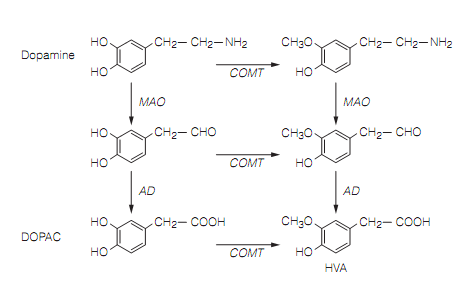Inactivation of dopamine
The Inactivation is by diffusion and reuptake in the nerve cell by a high affinity Na+/Cl-- dependent dopamine transporter. The Neurons which release their dopamine into the hypothalamic-pituitary portal system lack the dopamine transporter. Dopamine transporter is competitively inhibited by the amphetamines and by cocaine that therefore potentiate the effects of dopamine at the synapse. This adds to the powerful reinforcing properties of these drugs that make them addictive.
The two major enzymes are included in catecholamine catabolism. The main dopamine metabolites in the CNS are homovanillic acid (HVA) and dihydroxyphenyl acetic acid (DOPAC). In primates, the main catabolic route is through HVA and this is the fate of dopamine released into the cleft that escapes reuptake. It needs the sequential action of catechol-O-methyl transferase (COMT) and monoamine oxidase (MAO), both of which are here in neuronal membranes as shown in figure. Cytoplasmic dopamine which is not transported into vesicles remains free in the axon where it is catabolized by the MAO situated on the outer membrane of mitochondria, then through aldehyde dehydrogenase, a soluble cyto-solic enzyme, to the dihydroxyphenyl acetic acid.

Figure: Metabolism of dopamine.Here DOPAC=dihydroxyphenyl acetic acid; HVA=homovanillic acid; COMT=catechol-O-methyl transferase; MAO=monoamine oxidase; AD=alcohol dehydrogenase.